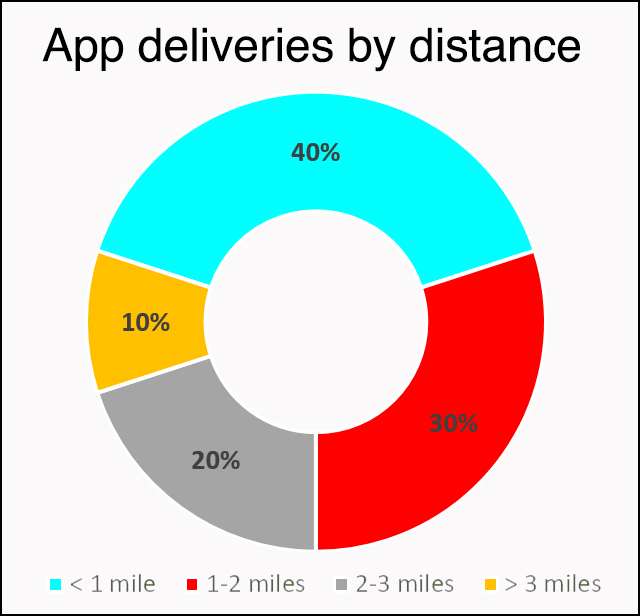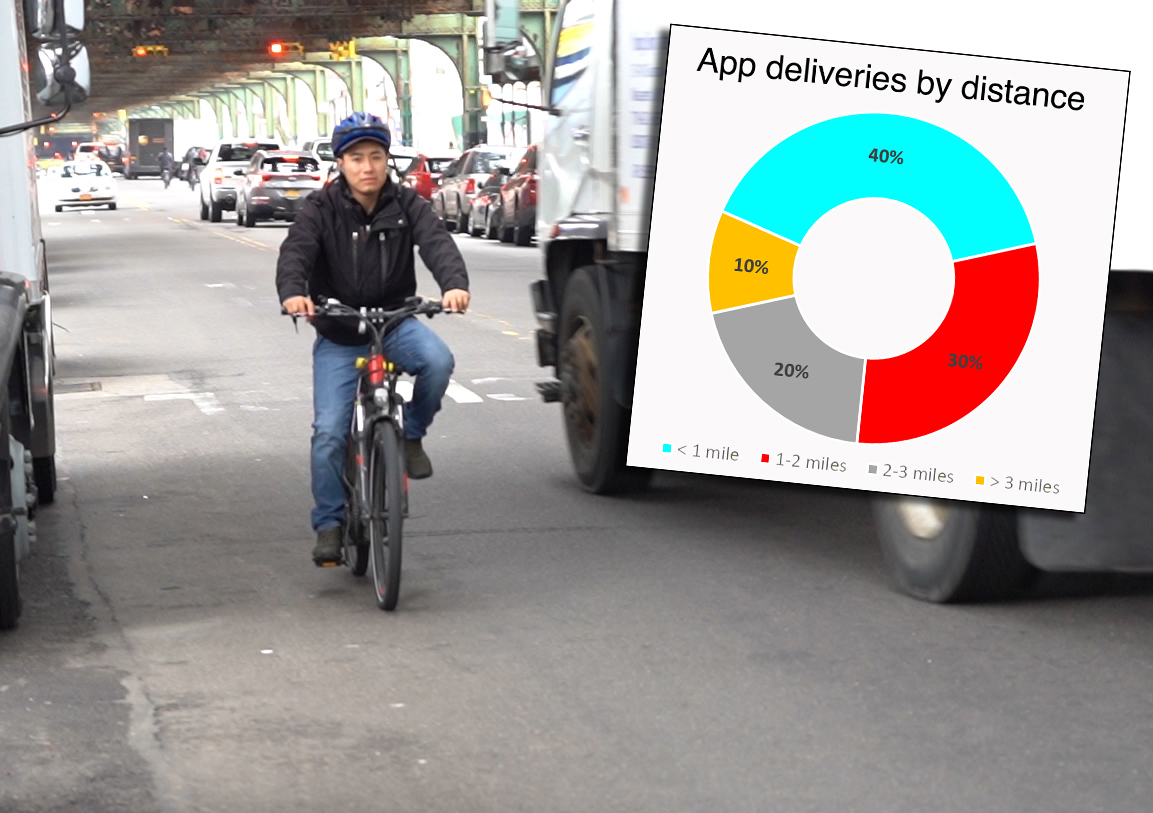Bicycle food-delivery in New York City is broken — not just because it’s essentially unregulated, but also because it’s unpriced.
Failure to price deliveries by distance leads New Yorkers to order from three miles away even though three blocks might suffice. The result is lots of unnecessary e-bike miles and excessive battery charging, whose costs are only now being confronted.
Fires ignited by exploding, substandard e-bike batteries, the majority from delivery bikes, have scarred or outright destroyed at least a dozen buildings around the city — most recently last Sunday, a supermarket on East 181st Street in the Bronx. Just in the past year, the toll is several deaths and scores of injuries.
On the roads, critics say delivery workers make conditions dicier for just about everyone: Pedestrians are discombobulated, non-working cyclists are discomfited by having to share already narrow bike lanes with speedier vehicles, and the delivery riders themselves risk life and limb, with 23 killed in crashes just since 2020, as reported to me by Los Deliveristas Unidos, a collective organized by the Workers Justice Project.
There is a lot of cycling going on, but the safety-in-numbers effect — the dynamic of more cyclists making cycling safer — is barely detectable.
People are quick to blame delivery workers for these maladies, but they are rooted in economic exploitation. This is why I believe a mileage charge on app-based delivery could help.
A modest distanced-based charge averaging a tad under $1 per order could generate $100 million a year — a revenue stream that could help deliveristas switch to certified, safe batteries and also finance a network of charging stations across the city.

The charge would encourage take-out customers to order from eateries closer to home, cutting down on superfluous delivery miles that necessitate e-bikes over ordinary bikes and add to street chaos stressing out pedestrians and human-powered cyclists.
The charge would be set by the city, itemized and authorized via the app, and paid by the app customers, not the delivery workers. It must be large enough to motivate customers to preference nearby restaurants, but not so large as to tank the delivery sector or shift it to motor vehicles. Its administration should be seamless (lower case), but transparent so customers see the price premium before, not after, they’ve settled on their order.
I have in mind a delivery charge of one dollar per mile, with the first mile free. Thus, a half-mile delivery would be uncharged, while a three-and-a-half mile delivery trip would be charged $2, based on the trip’s two miles (rounded down) beyond the first. Double rates would apply for Lower and Midtown Manhattan, where foot traffic and road congestion are heaviest.
My rate benchmark is my ongoing analyses of congestion costs from driving in New York City. Through painstaking traffic modeling (and some cool math), I’ve determined that driving an automobile for a random mile in Manhattan south of 60th Street during the 2-8 p.m. weekday peak slows down other vehicles on the streets by an aggregate 25 minutes. Factoring the value of drivers’ time, the collective slowdown equates to social delay-costs of around $25 per mile driven. Outside of the overnight “graveyard shift” — during 6 a.m.-2 p.m. and 8-11 p.m. — the delay cost dips to $15 per mile, giving an overall average during delivery hours of $20 or so.
An e-bike isn’t a car, of course. I posit that e-bike miles compound road congestion only around one-tenth as much as car miles. This means that a typical e-bike mile traveled in mid- or lower Manhattan imposes social delay costs of $2 per mile. (I ignore the deadhead return trip for conservatism.) Since congestion costs outside prime Manhattan are less by around half, the prevailing charge should be a dollar per mile.
The proceeds should go to a new, city-chartered entity charged with building and operate safe-charging depots and rest stations for the riders across the city. But the first order of business for the new revenue must be subsidizing delivery riders to swap out unsafe e-bike batteries for UL-certified brands, at little or no cost, a proposal first floated by Streetsblog.
Remaining revenues should pay for deliverista health and injury care and a wage floor — similar to that for New York City taxi drivers — which might ease, even if only slightly, the pressure to bike unsafely.
Unlike economic incentives to reduce driving, like congestion pricing, I don’t have empirical data to help estimate how much the fee would shrink delivery mileages. My gut feeling is that the impact would be substantial, given the city’s abundance of attractive, affordable restaurants and food prep shops.
Regardless, one of the advantages of internalizing societal costs through pricing is that the benefits are robust regardless of whether the changes in behavior are large or small. If large, city streets become much saner and safer; if small, the remediation fund fills up even faster.
Journalist Ross Barkan wrapped up his story this week on “the looming public safety crisis” from e-bike fires by noting that “New York was a thriving city with a wonderful restaurant scene before [app-based food-delivery services like DoorDash or Grubhub] began operating. Getting takeout in 2004 or 1997 or 1983 was never a particular challenge. Ordinary, environmentally friendly bicycles worked just fine. And they never caught fire.”
Focusing on battery fires, Barkan understandably didn’t mention that the past decade’s 10-fold jump in food-delivery cycling has vastly outstripped increases in bike lanes or other improvements to the general streetscape.
But bike lanes can’t lessen battery fire dangers. And whether the e-bike genie can, or even should, be put back in the bottle is an open question. A mileage charge can help rein in their street stress and pay for a plan to extinguish their fire danger. Let’s get started.
Charles Komanoff is a longtime Streetsblog contributor and also runs the Carbon Tax Center. See his prior stories here.






